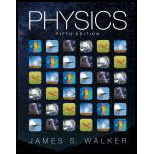
Concept explainers
Resolving Lines on an HDTV
The American Television Systems Committee (ATSC) sets the standards for high-definition television (HDTV). One of the approved HDTV formats is 1080p, which means 1080 horizontal lies scanned progressively (p)—that is, one line after another in sequence from top to bottom. Another standard is 1080, which stands for 1080 lines interfaced (i). In this system it takes two scans of the screen to show a complete picture the first scan shows the “even” horizontal lines, the second scan shows the “odd” horizontal lines. Interlacing was the norm for television displays until the 1970s, and is still used in most standard-definition TVs today. Progressive scanning became more popular with the advent of computer monitors, and is used today in LCD, DIP, and plasma HDTVs.
In addicting, the ATSC sets the standard for the shape of displays. For example it defines a “wide screen” to be one with a 16:9 ratio; that is, the width of the display is greater than the height by the factor 16/9. The ratio is just a little larger than the golden ratio,
For the following problems assume that 1080 horizontal lines are displayed on a television with a screen that is 15 7 inches high (32-inch diagonal), and that the light coming from the screen has a wavelength of 645 nm Also, assume that the pupil of your eye has a diameter of 5.50 mm. and that the index of refraction 01 the interior of the eye is 1.36.
• what is the angular separation of the horizontal lines as viewed from a distance of 12.0 feet?
- A. 1.01 × 10−4rad
- B. 2.53 × 10−4rad
- C. 2.56 × 10−4rad
- D. 12.1 × 10−4rad
Want to see the full answer?
Check out a sample textbook solution
Chapter 28 Solutions
Physics (5th Edition)
Additional Science Textbook Solutions
Anatomy & Physiology (6th Edition)
Chemistry (7th Edition)
Microbiology: An Introduction
Introductory Chemistry (6th Edition)
Human Biology: Concepts and Current Issues (8th Edition)
Cosmic Perspective Fundamentals
- pls help on thesearrow_forward20. Two small conducting spheres are placed on top of insulating pads. The 3.7 × 10-10 C sphere is fixed whie the 3.0 × 107 C sphere, initially at rest, is free to move. The mass of each sphere is 0.09 kg. If the spheres are initially 0.10 m apart, how fast will the sphere be moving when they are 1.5 m apart?arrow_forwardpls help on allarrow_forward
- 19. Mount Everest, Earth's highest mountain above sea level, has a peak of 8849 m above sea level. Assume that sea level defines the height of Earth's surface. (re = 6.38 × 106 m, ME = 5.98 × 1024 kg, G = 6.67 × 10 -11 Nm²/kg²) a. Calculate the strength of Earth's gravitational field at a point at the peak of Mount Everest. b. What is the ratio of the strength of Earth's gravitational field at a point 644416m below the surface of the Earth to a point at the top of Mount Everest? C. A tourist watching the sunrise on top of Mount Everest observes a satellite orbiting Earth at an altitude 3580 km above his position. Determine the speed of the satellite.arrow_forwardpls help on allarrow_forwardpls help on allarrow_forward
- 6. As the distance between two charges decreases, the magnitude of the electric potential energy of the two-charge system: a) Always increases b) Always decreases c) Increases if the charges have the same sign, decreases if they have the opposite signs d) Increases if the charges have the opposite sign, decreases if they have the same sign 7. To analyze the motion of an elastic collision between two charged particles we use conservation of & a) Energy, Velocity b) Momentum, Force c) Mass, Momentum d) Energy, Momentum e) Kinetic Energy, Potential Energyarrow_forwardpls help on all asked questions kindlyarrow_forwardpls help on all asked questions kindlyarrow_forward
 Physics for Scientists and Engineers, Technology ...PhysicsISBN:9781305116399Author:Raymond A. Serway, John W. JewettPublisher:Cengage Learning
Physics for Scientists and Engineers, Technology ...PhysicsISBN:9781305116399Author:Raymond A. Serway, John W. JewettPublisher:Cengage Learning University Physics Volume 3PhysicsISBN:9781938168185Author:William Moebs, Jeff SannyPublisher:OpenStax
University Physics Volume 3PhysicsISBN:9781938168185Author:William Moebs, Jeff SannyPublisher:OpenStax College PhysicsPhysicsISBN:9781285737027Author:Raymond A. Serway, Chris VuillePublisher:Cengage Learning
College PhysicsPhysicsISBN:9781285737027Author:Raymond A. Serway, Chris VuillePublisher:Cengage Learning College PhysicsPhysicsISBN:9781938168000Author:Paul Peter Urone, Roger HinrichsPublisher:OpenStax College
College PhysicsPhysicsISBN:9781938168000Author:Paul Peter Urone, Roger HinrichsPublisher:OpenStax College Physics for Scientists and Engineers: Foundations...PhysicsISBN:9781133939146Author:Katz, Debora M.Publisher:Cengage Learning
Physics for Scientists and Engineers: Foundations...PhysicsISBN:9781133939146Author:Katz, Debora M.Publisher:Cengage Learning College PhysicsPhysicsISBN:9781305952300Author:Raymond A. Serway, Chris VuillePublisher:Cengage Learning
College PhysicsPhysicsISBN:9781305952300Author:Raymond A. Serway, Chris VuillePublisher:Cengage Learning





